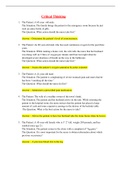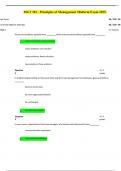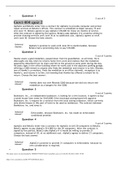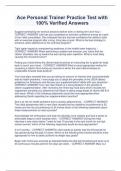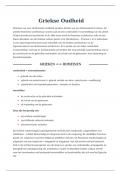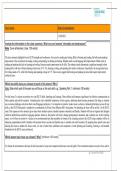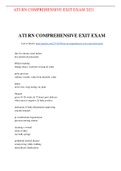Contents
Part 1: Corporate purpose, Corporate social responsibility, Shareholder vs stakeholder value, and the
B-corporation.........................................................................................................................................2
(Part 2 was a guest lecture)...................................................................................................................6
Part 3: ESG Reporting and ESG Metrics..................................................................................................6
Part 4: Does high CSR performance lead to high Financial Performance?...........................................15
Part 5: ESG performance and the cost of capital.................................................................................18
Part 6: Spread and Impact of Sustainability through Corporate Transactions, and Corporate
Monitoring...........................................................................................................................................20
Part 7: Activism on Corporate Social Responsibility.............................................................................30
(Part 8 was a guest lecture).................................................................................................................32
Part 9: Banks and ESG Loan Screening.................................................................................................32
Part 10: Green Bonds and Social Impact Bonds...................................................................................35
Part 11: Climate Change and Other Environmental Considerations....................................................38
(Part 12 was a guest lecture)...............................................................................................................46
(Part 13: cancelled)..............................................................................................................................46
Part 14: ESG Preferences, Donations, and Altruism.............................................................................46
Part 15: Employee Engagement...........................................................................................................50
(Part 16 was a guest lecture)...............................................................................................................54
Part 17: Greenwashing........................................................................................................................54
1
,Part 1: Corporate purpose, Corporate social responsibility, Shareholder vs stakeholder value, and the B-
corporation.
Mandatory paper: Bebchuck, Kastiel & Tallarita (2022): Does Enlightened Shareholder Value Add Value?
Shareholder Value Maximization (SVM): Net present value = sum of discounted cashflows. Discount factor =
weighted average cost of capital (WACC).
= optimal capital structure. Firm should adopt. + Tax shield.
Return on equity = CAPM = Rf + Beta*(E(Rm)-Rf)
Beta = covariance(Ri,Rm) / Variance of market. Systematic risk (market based risk).
CAPM doesn’t include variance (risk) of the firm: because you can diversify this risk.
Why take a long time when investigating returns: to include booms, and downward trends, to avoid bias.
Enhanced Shareholder Value Maximization (ESMV)
Focus on all stakeholders, not only the shareholders.
Constituencies: parties involved with the firm.
What are companies allowed to do?
Legal context:
- Europe: civil law. Stakeholder is embedded in law.
- US/UK: common law. Based on what is written down, judges are the law.
o US: Shareholder primacy: comes in 1st place. Other stakeholders have contracts, shareholders
do not, however. Once everyone is paid, he owns the company, anything left is for ‘him’.
o Constituency statutes: firms will also take care of constituencies. Deviate from the primacy.
Can take care of stakeholders, without violating primacy.
o UK: Stakeholders are mentioned in UK CO Act. But, shareholder primacy is still there.
ESVM: consider the interest of the stakeholder. This will serve long-term SVM.
Take care of the whole eco-environment of the company. Boundaries of the company: taking care of employees,
community, customers, and supply chain. It should always be long-term value creation.
Long term value depends on stakeholders:
- Employees: human capital;
- Community of tax payers: (institutional) infrastructure;
- Customers: revenues;
- Firms: supply chain.
Support form:
a. Corporate leadership
o US Business Roundtable: many embrace an ESV approach, although they don’t admit it.
o Corporate purpose statements: guidelines of certain companies.
o Davos Manifesto (World Economic Forum): stakeholder capitalism.
b. Institutional investors
o Big3 (universal ownership: BlackRock, State Street & Vanguard) say: serve the full set of
stakeholders. Managing systemic risks and tackle climate change.
o BlackRock: CEO says firm should create value for and be valued by its full range of
stakeholders. Stakeholder capitalism is about delivering long-term durable returns for
shareholders.
o State Street: ESG issues are good business practice.
o Vanguard: Climate change in terms of risks. It’s a risk issue if you don’t care about these
issues. The issues deliver value to investors.
Doing well by doing good.
o Public pension funds: are traditional activists and now also on CSR issues. Climate risk
reporting. Want to protect their investments. Endorse ESVM version of stakeholder capitalism.
o Shareholder proposals on ESG by institutional investors: proposals for greener projects to
protect shareholder value against regulatory risk.
Is it a win-win?
In theory, it is. However, there are many cases where it isn’t. In reality: trade-off choice. Between shareholder
and stakeholder interests.
2
,Many more opportunities to improve stakeholder welfare at the expense of shareholders. How far are they
willing to go?
(Example: more oil wells for shareholders, but society suffers. Moving labour to cheaper countries for more profit,
however it results in reputational and moral costs.)
Tax avoidance: adopting structures to reduce tax liabilities, in compliance with the law.
This is a trade-off between the interests of shareholders and of taxpayers and society.
ESVM is different from SVM if the first leads to fuller consideration of stakeholder effects.
For ESVM to be equal to SVM:
- Corporate leaders are not myopic (short-sighted) and consider the long-term consequences of their
choices on long-term shareholder value;
- They are well-informed about consequences of their choices;
- Courts avoid micromanagement of corporate decisions and defer to the discretion of corporate leaders
under the business judgement rule;
- Only changes in the actual treatment of stakeholders, and not merely linguistic changes in the
formulation of decisions are taken to be actual changes (= no greenwashing).
ESVM differs from SVM:
- Focus on the long-term (but it’s not always better!)
- Education and informational value of ESVM (consideration of stakeholders, doing good and does it lead
to greenwashing?)
- Using ESVM as an excuse to deviate from value maximization (beyond legal cover?)
Conclusion on ESVM:
Could help to focus on stakeholder constraints on value, could be unhelpful but harmless (new wine in old bags),
and could be counter-productive if it induces misperceptions and illusionary misperceptions or destroys value.
Problem with SVM: is good with the conditions of a perfect competitive economy with no agent to affect prices
and without externalities.
Then, SVM increases the wealth of shareholders without others being worse off. Other stakeholders are
protected by contracts.
However, the conditions are not fulfilled. There are always externalities.
SVM breaks down:
- Imperfect competition: danger of monopoly/monopsony power in the goods markets
(consumers/customers are completely ripped off)
- Common ownership (maximization does not happen on the company level but multiple company levels
maximize your value as an owner for portfolio firms, not individual firms). Max firm value of firm B
(100%) with use of firm A (50% + 1 share).
- Externalities. Many externalities are cross-border: can’t regulate in a country. They are also inseparable
from the production activities.
Friedman Separation Theorem (individuals should invest in preserving the environment): a separation of value
maximization and paying for externalities.
Pure SVM is amoral (not immoral), careless about right or wrong.
SWM = Shareholder Welfare Maximization. = SVM + regulation AND/OR shareholder voting on ESG issues.
However:
- Voting is binding in Europe, not in US and UK.
- Institutional investors will only vote in favour of long-term financial return of clients.
- Will shareholders actually vote?
Solution = delegated voting (for example ISS). Pay a fee to have this ISS vote for you. You can join a voters
profile.
Requires that mutual funds have a clearly specified voting policy.
Issues to be voted on should be relevant: comparative advantage for the firm. Also there should be a minimal
investment for shareholders to be able to make a proposal. Furthermore, it must be related to the business.
Corporate Purpose statement
CP = statement: “to make money legally, businesses generally must offer a useful product and attractive
employment, etc.”
If doing good is valuable, will you earn higher returns when investing in these companies? Or: Do stocks with
ESG ratings earn a higher return than non-ESG stocks?
- Good businesses get capital at more favourable terms (lower cost of capital). They have a lower risk
and therefore have a lower return in equilibrium. ‘Sin’ stocks thus have a higher return (and more risk).
3
, Out of equilibrium, if there’s a shock (for example a higher ESG score): the demand goes up, then the price goes
up, it gains a higher initial return, which means longer term higher prices and therefore lower returns.
There’s no need for a CP statement. Firms do automatically consider stakeholders (they don’t state that their only
goal is to make money).
But, CP commitment is not sufficient: stakeholders have contracts to protect them (labour, loan covenant). But,
any contract is incomplete: one cannot foresee everything. And not all stakeholders have contracts.
Corporate governance mechanism.
What is the focus of the fiduciary duties (the legal responsibility to act solely in the best interest of another party)?
Corporate level
- = legal directives as to how managers and directors should exercise their discretion left by external
regulation.
- Shareholder primacy vs stakeholderism (concern for various constituents beyond shareholders).
- Fiduciary duties on the shareholder primacy: fear that SVM forces managers and directors to sacrifice
potentially unlimited social welfare for infinitesimal shareholder wealth gains.
- Fear is misplaced: far less shareholder centric/and shareholder-stakeholder distinction makes no
practical legal difference.
- Reason: business judgement rule: courts will not interfere with decisions taken by top managers.
Fiduciary duties differ by state.
Investment trustees. They are subject to stricter fiduciary duties; less opportunity to justify ‘social’ acts with the
profitability of long term commitment.
Board elections and representation
- Shareholders appoint the board;
- But in Europe; board seats in context of board determination / minority shareholders / independence of
directors;
- Quotas for gender, minorities.
Broader social goals.
Executive pay
- Is set by the board;
- Focus on stock price: long term incentives and forward-looking benchmark;
- Stock price could be a metric for social welfare;
- Stock price includes effects on reputation, employee engagement (with higher personnel costs but
porducivity increases);
- Recent move to include ESG-related factors.
Advantage of CP:
- The commitment by means of CP = trust.
- Many stakeholders are protected by contracts, however, the shareholder is not! (commitment to
shareholder returns is important).
- For the shareholder: legal shareholder protection is needed and focus on shareholder primacy.
Which stakeholders will the company choose? This is decided through regulation.
However, what if the democratic process is too slow? (For the climate for example) Or if it is dysfunctional?
Regulation should reflect moral norms. However, not everything can be regulated and regulation is not always
perfect.
Suppose regulation works well: what about lobbying? Should it be banned?
Should a corporate purpose statement be mandatory? It is endogenous: Causality problem between CP
statement and profit/value.
- Policy implications will be unclear:
o Purpose statements may only work for few firms that adopted them, might be useless for
others. Forcing all to adopt destroys the distinguishing value.
o A regulator can only set minimum requirements for mandatory purpose statements. These
might end up being different from voluntary statements (may be richer).
B Corp versus Benefit corporation
Mandatory paper: Marquis (2020): The B Crop Movement Goes Big.
B Corp
In the U.S. many states allow constituency statutes: allows firm not to focus only on shareholders.
B Corp is a for-profit corporation, certified by the non-profit B Labs. Commits to:
- Accountability: directors must consider impact on all stakeholders.
- Transparency: they publish public reports of overall environmental & social performance.
4
Part 1: Corporate purpose, Corporate social responsibility, Shareholder vs stakeholder value, and the
B-corporation.........................................................................................................................................2
(Part 2 was a guest lecture)...................................................................................................................6
Part 3: ESG Reporting and ESG Metrics..................................................................................................6
Part 4: Does high CSR performance lead to high Financial Performance?...........................................15
Part 5: ESG performance and the cost of capital.................................................................................18
Part 6: Spread and Impact of Sustainability through Corporate Transactions, and Corporate
Monitoring...........................................................................................................................................20
Part 7: Activism on Corporate Social Responsibility.............................................................................30
(Part 8 was a guest lecture).................................................................................................................32
Part 9: Banks and ESG Loan Screening.................................................................................................32
Part 10: Green Bonds and Social Impact Bonds...................................................................................35
Part 11: Climate Change and Other Environmental Considerations....................................................38
(Part 12 was a guest lecture)...............................................................................................................46
(Part 13: cancelled)..............................................................................................................................46
Part 14: ESG Preferences, Donations, and Altruism.............................................................................46
Part 15: Employee Engagement...........................................................................................................50
(Part 16 was a guest lecture)...............................................................................................................54
Part 17: Greenwashing........................................................................................................................54
1
,Part 1: Corporate purpose, Corporate social responsibility, Shareholder vs stakeholder value, and the B-
corporation.
Mandatory paper: Bebchuck, Kastiel & Tallarita (2022): Does Enlightened Shareholder Value Add Value?
Shareholder Value Maximization (SVM): Net present value = sum of discounted cashflows. Discount factor =
weighted average cost of capital (WACC).
= optimal capital structure. Firm should adopt. + Tax shield.
Return on equity = CAPM = Rf + Beta*(E(Rm)-Rf)
Beta = covariance(Ri,Rm) / Variance of market. Systematic risk (market based risk).
CAPM doesn’t include variance (risk) of the firm: because you can diversify this risk.
Why take a long time when investigating returns: to include booms, and downward trends, to avoid bias.
Enhanced Shareholder Value Maximization (ESMV)
Focus on all stakeholders, not only the shareholders.
Constituencies: parties involved with the firm.
What are companies allowed to do?
Legal context:
- Europe: civil law. Stakeholder is embedded in law.
- US/UK: common law. Based on what is written down, judges are the law.
o US: Shareholder primacy: comes in 1st place. Other stakeholders have contracts, shareholders
do not, however. Once everyone is paid, he owns the company, anything left is for ‘him’.
o Constituency statutes: firms will also take care of constituencies. Deviate from the primacy.
Can take care of stakeholders, without violating primacy.
o UK: Stakeholders are mentioned in UK CO Act. But, shareholder primacy is still there.
ESVM: consider the interest of the stakeholder. This will serve long-term SVM.
Take care of the whole eco-environment of the company. Boundaries of the company: taking care of employees,
community, customers, and supply chain. It should always be long-term value creation.
Long term value depends on stakeholders:
- Employees: human capital;
- Community of tax payers: (institutional) infrastructure;
- Customers: revenues;
- Firms: supply chain.
Support form:
a. Corporate leadership
o US Business Roundtable: many embrace an ESV approach, although they don’t admit it.
o Corporate purpose statements: guidelines of certain companies.
o Davos Manifesto (World Economic Forum): stakeholder capitalism.
b. Institutional investors
o Big3 (universal ownership: BlackRock, State Street & Vanguard) say: serve the full set of
stakeholders. Managing systemic risks and tackle climate change.
o BlackRock: CEO says firm should create value for and be valued by its full range of
stakeholders. Stakeholder capitalism is about delivering long-term durable returns for
shareholders.
o State Street: ESG issues are good business practice.
o Vanguard: Climate change in terms of risks. It’s a risk issue if you don’t care about these
issues. The issues deliver value to investors.
Doing well by doing good.
o Public pension funds: are traditional activists and now also on CSR issues. Climate risk
reporting. Want to protect their investments. Endorse ESVM version of stakeholder capitalism.
o Shareholder proposals on ESG by institutional investors: proposals for greener projects to
protect shareholder value against regulatory risk.
Is it a win-win?
In theory, it is. However, there are many cases where it isn’t. In reality: trade-off choice. Between shareholder
and stakeholder interests.
2
,Many more opportunities to improve stakeholder welfare at the expense of shareholders. How far are they
willing to go?
(Example: more oil wells for shareholders, but society suffers. Moving labour to cheaper countries for more profit,
however it results in reputational and moral costs.)
Tax avoidance: adopting structures to reduce tax liabilities, in compliance with the law.
This is a trade-off between the interests of shareholders and of taxpayers and society.
ESVM is different from SVM if the first leads to fuller consideration of stakeholder effects.
For ESVM to be equal to SVM:
- Corporate leaders are not myopic (short-sighted) and consider the long-term consequences of their
choices on long-term shareholder value;
- They are well-informed about consequences of their choices;
- Courts avoid micromanagement of corporate decisions and defer to the discretion of corporate leaders
under the business judgement rule;
- Only changes in the actual treatment of stakeholders, and not merely linguistic changes in the
formulation of decisions are taken to be actual changes (= no greenwashing).
ESVM differs from SVM:
- Focus on the long-term (but it’s not always better!)
- Education and informational value of ESVM (consideration of stakeholders, doing good and does it lead
to greenwashing?)
- Using ESVM as an excuse to deviate from value maximization (beyond legal cover?)
Conclusion on ESVM:
Could help to focus on stakeholder constraints on value, could be unhelpful but harmless (new wine in old bags),
and could be counter-productive if it induces misperceptions and illusionary misperceptions or destroys value.
Problem with SVM: is good with the conditions of a perfect competitive economy with no agent to affect prices
and without externalities.
Then, SVM increases the wealth of shareholders without others being worse off. Other stakeholders are
protected by contracts.
However, the conditions are not fulfilled. There are always externalities.
SVM breaks down:
- Imperfect competition: danger of monopoly/monopsony power in the goods markets
(consumers/customers are completely ripped off)
- Common ownership (maximization does not happen on the company level but multiple company levels
maximize your value as an owner for portfolio firms, not individual firms). Max firm value of firm B
(100%) with use of firm A (50% + 1 share).
- Externalities. Many externalities are cross-border: can’t regulate in a country. They are also inseparable
from the production activities.
Friedman Separation Theorem (individuals should invest in preserving the environment): a separation of value
maximization and paying for externalities.
Pure SVM is amoral (not immoral), careless about right or wrong.
SWM = Shareholder Welfare Maximization. = SVM + regulation AND/OR shareholder voting on ESG issues.
However:
- Voting is binding in Europe, not in US and UK.
- Institutional investors will only vote in favour of long-term financial return of clients.
- Will shareholders actually vote?
Solution = delegated voting (for example ISS). Pay a fee to have this ISS vote for you. You can join a voters
profile.
Requires that mutual funds have a clearly specified voting policy.
Issues to be voted on should be relevant: comparative advantage for the firm. Also there should be a minimal
investment for shareholders to be able to make a proposal. Furthermore, it must be related to the business.
Corporate Purpose statement
CP = statement: “to make money legally, businesses generally must offer a useful product and attractive
employment, etc.”
If doing good is valuable, will you earn higher returns when investing in these companies? Or: Do stocks with
ESG ratings earn a higher return than non-ESG stocks?
- Good businesses get capital at more favourable terms (lower cost of capital). They have a lower risk
and therefore have a lower return in equilibrium. ‘Sin’ stocks thus have a higher return (and more risk).
3
, Out of equilibrium, if there’s a shock (for example a higher ESG score): the demand goes up, then the price goes
up, it gains a higher initial return, which means longer term higher prices and therefore lower returns.
There’s no need for a CP statement. Firms do automatically consider stakeholders (they don’t state that their only
goal is to make money).
But, CP commitment is not sufficient: stakeholders have contracts to protect them (labour, loan covenant). But,
any contract is incomplete: one cannot foresee everything. And not all stakeholders have contracts.
Corporate governance mechanism.
What is the focus of the fiduciary duties (the legal responsibility to act solely in the best interest of another party)?
Corporate level
- = legal directives as to how managers and directors should exercise their discretion left by external
regulation.
- Shareholder primacy vs stakeholderism (concern for various constituents beyond shareholders).
- Fiduciary duties on the shareholder primacy: fear that SVM forces managers and directors to sacrifice
potentially unlimited social welfare for infinitesimal shareholder wealth gains.
- Fear is misplaced: far less shareholder centric/and shareholder-stakeholder distinction makes no
practical legal difference.
- Reason: business judgement rule: courts will not interfere with decisions taken by top managers.
Fiduciary duties differ by state.
Investment trustees. They are subject to stricter fiduciary duties; less opportunity to justify ‘social’ acts with the
profitability of long term commitment.
Board elections and representation
- Shareholders appoint the board;
- But in Europe; board seats in context of board determination / minority shareholders / independence of
directors;
- Quotas for gender, minorities.
Broader social goals.
Executive pay
- Is set by the board;
- Focus on stock price: long term incentives and forward-looking benchmark;
- Stock price could be a metric for social welfare;
- Stock price includes effects on reputation, employee engagement (with higher personnel costs but
porducivity increases);
- Recent move to include ESG-related factors.
Advantage of CP:
- The commitment by means of CP = trust.
- Many stakeholders are protected by contracts, however, the shareholder is not! (commitment to
shareholder returns is important).
- For the shareholder: legal shareholder protection is needed and focus on shareholder primacy.
Which stakeholders will the company choose? This is decided through regulation.
However, what if the democratic process is too slow? (For the climate for example) Or if it is dysfunctional?
Regulation should reflect moral norms. However, not everything can be regulated and regulation is not always
perfect.
Suppose regulation works well: what about lobbying? Should it be banned?
Should a corporate purpose statement be mandatory? It is endogenous: Causality problem between CP
statement and profit/value.
- Policy implications will be unclear:
o Purpose statements may only work for few firms that adopted them, might be useless for
others. Forcing all to adopt destroys the distinguishing value.
o A regulator can only set minimum requirements for mandatory purpose statements. These
might end up being different from voluntary statements (may be richer).
B Corp versus Benefit corporation
Mandatory paper: Marquis (2020): The B Crop Movement Goes Big.
B Corp
In the U.S. many states allow constituency statutes: allows firm not to focus only on shareholders.
B Corp is a for-profit corporation, certified by the non-profit B Labs. Commits to:
- Accountability: directors must consider impact on all stakeholders.
- Transparency: they publish public reports of overall environmental & social performance.
4




